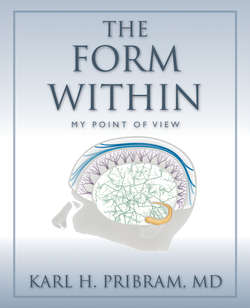Читать книгу The Form Within - Karl H Pribram - Страница 37
На сайте Литреса книга снята с продажи.
The Two Processes That Form Patterns in Our Brains
ОглавлениеTo review briefly: The circuits of our brain consisting of large nerve fibers, axons, have sufficient girth to sustain the transmission of nerve impulses produced by complete depolarization—the discharge of the electrical polarization—of their membranes. The nerve impulses, acting like sparks, can travel along the nerve over long distances.
The nature of processing in circuits of the brain has been well documented and is therefore well established within the neuroscience community. Neuroscientists have focused on nerve impulse transmission in large nerve fibers because, due to the available experimental tools over the past century, this aspect of brain function has been more accessible to us and has yielded results that are easy to interpret and to understand. (To anticipate a discussion later in this chapter: circuits are of two sorts, flexible short-range assemblies and fixed long-range connections.)
By contrast, the fine fibers composing the web—the branches or dendrites of nerve cells—cannot sustain nerve impulse conduction the way axons can. The electrical activity of dendrites rarely “sparks” but oscillates between excitation and inhibition; thus, dendritic activity occurs locally, forming patches or nodes of synchronized oscillating activity.
The dendritic patches, the nodes, are not only produced by electrical and chemical activity at the junctions (synapses and ephapses) that connect the fine fibers, but also independently of what is going on at these junctions: Dendrites have been found to secrete chemical modulators in conjunction with the glia or “glue” cells that surround them. The patches of activity that are carried on within the fine fibers in our brain thus form a neuro-nodal web.
Unlike the longer-range activity of large nerve fibers, the coordinating influence of dendrites on neighboring regions of the brain results only from a local spread of excitation. The fact that dendritic processing is restricted to such a local patch posed a serious problem for me back in the mid-1960s when I first suggested its importance. How could the sort of global brain activity that is necessary to our thought, perception and memory be achieved from such isolated activities in small patches? Surprisingly, I found the resolution to my quandary in astrophysics.
12. The Dendritic Web
13. The Cortical Chem-Web Demonstrated by Staining Acetyl Choline Esterase Receptors
14. The Neuro-Nodal Web
Astrophysicists need to be able to explore large reaches of sky, but telescopes could capture only a small portion at any one viewing. They finally solved this problem by converting the images obtained through the telescope using a mathematical equation, the Fourier transformation— the procedure that Gabor used to invent holography—that will be referred to again and again in much of the rest of this book. The procedure works by Fourier-transforming adjacent images obtained by the telescope; patching them together and performing another transformation, the reverse of the initial transformation, on the patched whole, to give a usable image of large expanses of sky. This same procedure is now used routinely in current image processing in hospitals such as PET scans and fMRI.
When the formative processing web provided by the dendrites has to be accessed by the rest of the brain, axons relay the results of these interactions to other parts of the brain or to receptors and effectors in the body.
The neuroscience community as a whole has until recently tended to disregard completely what is going on in the fine-fibered branches, the dendrites, as well as ignoring the importance of what goes on within these webs, as illustrated above in the neuro-nodal and chem-webs. This despite the statements such as those by George Bishop, professor at Washington University in St. Louis, considered at the time to be the dean of neurophysiologists (during the 1950s), who repeatedly stated that processing in the nervous system is a function of its fine fibers; the results of processing are conveyed to other parts of the nervous system and to sensory and motor systems by circuits of axons. Another influential neuroscientist, Ted Bullock, professor at the University of California at San Diego, on the basis of his research experience, put it even more bluntly and detailed what is actually occurring in the fine-fibered processes, as described in the quotation that inaugurated this chapter.
His description of neural transactions as “a densely packed social gathering in which connections often skip neighbors and act upon more or less specific classes of nearby or even remote elements” fits what computer scientists describe as the makings of self-organizing systems.
Hopefully, in the past few years the scene has at last begun to change as heralded, for example, by an excellent review by R. Douglas Fields in the June/July 2006 issue of Scientific American MIND of the circuit vs. the web-like processing in the brain cortex.
